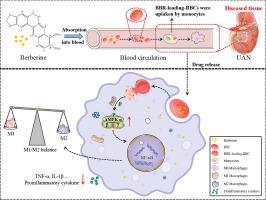Uric acid nephropathy (UAN), caused by a common metabolic disorder resulting from hyperuricemia (HUA), has an increasing incidence. Previous studies have shown that berberine (BBR) has clear urate-lowering and anti-inflammatory effects in UAN mice, but its mechanism needs to be further clarified. Therefore, Potassium Oxonate (PO) combined with hypoxanthine (HX) induced UAN mice model and MSU induced THP-1 cells polarization model were adopted to investigate the mechanism of BBR on UAN in terms of tissue distribution and molecular pharmacology. Study unveiled that BBR was first found to bind to red blood cells (RBCs), which were recognized and phagocytosed by monocytes, then recruited by the injured kidney. Subsequently, BBR was enriched and functional in damaged kidney. The results of in vivo experiments revealed that, BBR reduced UA, BUN, CRE levels as well as the release of TNF-α, IL-1β, IL-18 and IL-6, and alleviated renal injury in UAN mice, as consistent with previous studies. Additionally, BBR decreased MCP-1 expression, while diminishing macrophage infiltration and decreasing M1 proportion as determined by RT-qPCR. In vitro experiments, demonstrated that MSU promoted inflammatory polarization of THP-1 cells, while BBR reduced synthesis of inflammatory factors and inhibited MSU-induced inflammatory polarization. These effects of BBR were dependent on AMPK activation along with indirect inhibition of NF-κB signaling pathway mediated. However, the anti-inflammatory and macrophage polarization regulation effects of BBR were completely reversed upon administration of Compound C, an AMPK inhibitor. Therefore, BBR ameliorated kidney injury via regulating macrophage polarization through AMPK, which has therapeutic potential for UAN patients.

| 公司名称 | 产品信息 | 采购帮参考价格 | |
|---|---|---|---|
| 上海源叶 | Febuxostat |
>98%
|
¥27.00~¥39468.00 |
| Sigma | HX |
>98%
|
¥20.00~¥15466.00 |
| Sigma | PO |
>98%
|
¥18.00~¥8389.90 |

